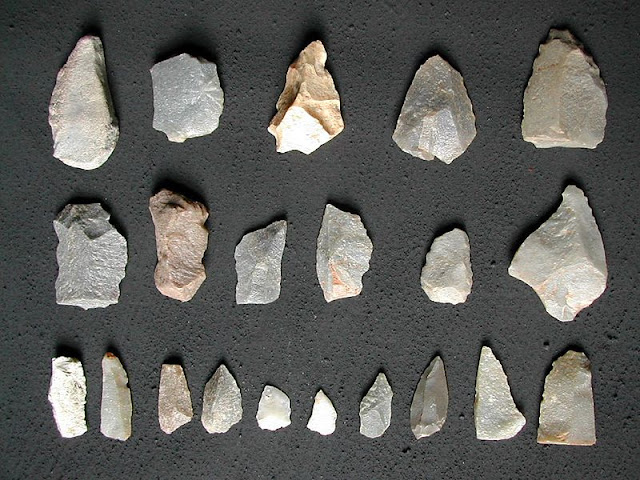 |
| Mesolithic Age Tools (Microliths) |
Features of Mesolithic Age in India
1. Known for much sharper, smaller, and better tools known as Microliths.
2. Early visible signs of pottery culture at Langhnaj (Gujarat), Tilwara (Rajasthan) and the Kaimur region of Mirzapur.
3. The beginning of plant cultivation at the last phase of this age.
4. Cave paintings were common now. These paintings are used to express various aspects of life. As the Mesolithic man started domesticating animals, the animals dominated the cave paintings.
5. The first rock paintings in India were discovered at Sohagighat (Kaimur Hills, Uttar Pradesh) in 1867. Now, over 150 Mesolithic rock art sites have been discovered across India, with a rich concentration in Central India such as the Bhimbetka Caves, Kharwar, Jaora, and Kathotia (Madhya Pradesh), Sundargarh and Sambalpur (Orissa), Ezhuthu Guha (Kerala).
6. Along with cave paintings, burials also give us an abstract idea about the development of religious practices and their reflection on the division of labour on the basis of age and gender.
7. Knowledge of fire.
Some of the important Mesolithic sites are
1. Bagor, Rajasthan on River Kothari is one of the largest Mesolithic sites in India.
2. Chhotanagpur Region, Central India.
3. Adamgarh, Madhya Pradesh along with Bagor provide us with the earliest proof of the domestication.
3. Tinnevelly, Tamil Nadu
4. Birbhanpur (Burdwan), West Bengal
5. Sarai Nahar Rai, Allahabad, Uttar Pradesh, burnt clay lumps and fire hearth are discovered from this site.
6. Mahadaha, Uttar Pradesh, here bone artifacts are found, including arrowheads and bone ornaments.
7. Mayurbhanj, Keonjhar, Sundergarh and Kuchai in Odisha
8. Sehargigi, Meghalaya
9. 25 microlithic sites are reported in the Shorapur doab region of Krishna and Bhima rivers.
Tags:
Indian History
